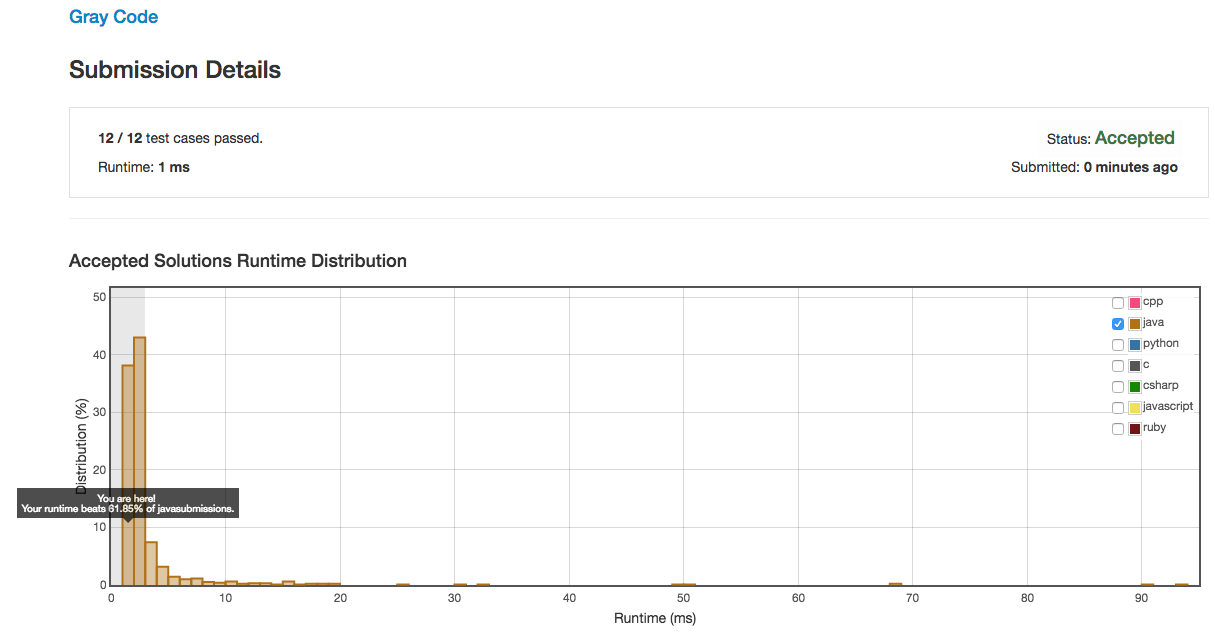89. Gray Code
题目:
The gray code is a binary numeral system where two successive values differ in only one bit.
Given a non-negative integer n representing the total number of bits in the code, print the sequence of gray code. A gray code sequence must begin with 0.
For example, given n = 2, return [0,1,3,2]. Its gray code sequence is:
00 - 0 01 - 1 11 - 3 10 - 2
Note:
For a given n, a gray code sequence is not uniquely defined.
For example, [0,2,3,1] is also a valid gray code sequence according to the above definition.
For now, the judge is able to judge based on one instance of gray code sequence. Sorry about that.
链接: http://leetcode.com/problems/gray-code/
题解:
求灰度值。利用定义来做就可以了。比如 00, 01, 11, 10的下一个灰度值为 000, 001, 011, 010 与 prefix 1再逆序的值 110, 111, 101, 100的和, 就是 000, 001, 010, 011, 110, 111, 101, 100。
public class Solution { public List<Integer> grayCode(int n) { List<Integer> res = new ArrayList<Integer>(); if(n < 0) return res; if(n == 0) { res.add(0); return res; } List<Integer> last = grayCode(n - 1); res.addAll(last); int prefix = (1 << n - 1); for(int i = last.size() - 1; i >= 0; i--) res.add(last.get(i) + prefix); return res; } }
二刷:
Java:
Time Complexity - O(2n), Space Complexity - O(2n)
public class Solution { public List<Integer> grayCode(int n) { List<Integer> res = new ArrayList<>(); if (n < 0) { return res; } if (n == 0) { res.add(0); return res; } List<Integer> last = grayCode(n - 1); res.addAll(last); int prefix = 1 << (n - 1); for (int i = last.size() - 1; i >= 0; i--) { res.add(prefix + last.get(i)); } return res; } }
也可以用类似memorization来降低space complexity = O(1),不考虑结果集的话
public class Solution { public List<Integer> grayCode(int n) { List<Integer> res = new ArrayList<>(); res.add(0); for (int i = 0; i < n; i++) { int prefix = 1 << i; for (int j = res.size() - 1; j >= 0; j--) { res.add(prefix + res.get(j)); } } return res; } }
三刷:
方法和上面一样。
Java:
Recursive:
Time Complexity - O(2n), Space Complexity - O(2n)
public class Solution { public List<Integer> grayCode(int n) { List<Integer> res = new ArrayList<>(); if (n <= 0) return Collections.singletonList(0); List<Integer> last = grayCode(n - 1); res.addAll(last); int prefix = 1 << (n - 1); for (int i = last.size() - 1; i >= 0; i--) res.add(prefix + last.get(i)); return res; } }
Iterative:
public class Solution { public List<Integer> grayCode(int n) { List<Integer> res = new ArrayList<>(); res.add(0); for (int i = 0; i < n; i++) { for (int j = res.size() - 1; j >= 0; j--) { res.add((1 << i) + res.get(j)); } } return res; } }

Reference:
https://leetcode.com/discuss/2978/what-solution-gray-code-problem-extra-space-used-recursion
https://leetcode.com/discuss/24634/an-accepted-three-line-solution-in-java
https://en.wikipedia.org/wiki/Gray_code




